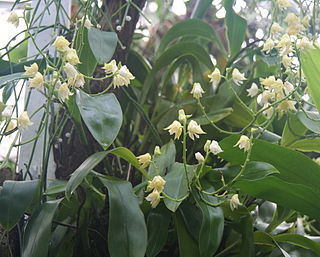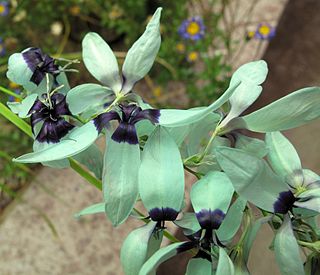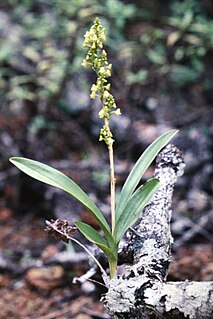
Iridaceae is a family of plants in order Asparagales, taking its name from the irises, meaning rainbow, referring to its many colours. There are 66 accepted genera with a total of c. 2244 species worldwide. It includes a number of other well known cultivated plants, such as freesias, gladioli and crocuses.

Ixia is a genus of cormous plants native to South Africa from the family Iridaceae. Some of them are known as the corn lily. Some distinctive traits include sword-like leaves and long wiry stems with star-shaped flowers. It usually prefers well-drained soil. The popular corn lily has specific, not very intense fragrance. It is often visited by many insects such as bees. The Ixia are also used sometimes as ornamental plants.

Echinochloa is a very widespread genus of plants in the grass family and tribe Paniceae. Some of the species are known by the common names barnyard grass or cockspur grass.

Dioscorea polystachya or Chinese yam, also called cinnamon-vine, is a species of flowering plant in the yam family. It is sometimes called Chinese potato or by its Japanese name nagaimo.

Aphanamixis polystachya, the pithraj tree, is a species of tree in the family Meliaceae. It is native to India, Pakistan, Nepal, Bhutan, Bangladesh, Myanmar and Sri Lanka. It is a widely used as a medicinal plant in Ayurveda.

Polystachya, abbreviated Pol in horticultural trade, and commonly known as yellowspike orchid, is a flowering plant genus in the orchid family (Orchidaceae). This rather distinctive genus was described by William Jackson Hooker in 1824 and is the type genus of the subtribe Polystachyinae. It contains about 100 species widespread across many of the tropical areas of the world.
Prunus polystachya, also called bat laurel, is a species of plant in the family Rosaceae. It is endemic to Singapore.

Ixia viridiflora, also known as turquoise ixia, is a tall member of the genus Ixia. It comes from around the Tulbagh in South Africa, Cape Province. It has small corms under the ground.

Crocoideae is one of the major subfamilies in the family Iridaceae.
Pseudechinolaena is a genus of tropical and subtropical plants in the grass family, all but one species endemic to Madagascar.

Polystachya concreta, the greater yellowspike orchid, is a species of orchid native to tropical and subtropical America, Africa and Asia.

Ixia maculata is a species of flowering plant in the family Iridaceae known by the common name spotted African corn lily. It is native to the Cape Provinces of South Africa, but it is grown widely as an ornamental plant. It can also be found growing wild as an introduced species in several areas, including Western Australia. This perennial flower grows 20 to 70 centimeters tall with an erect, unbranched stem. There are a few twisting basal leaves up to 35 centimeters long. The inflorescence is a dense, showy spike of up to 12 flowers, usually orange to yellow in color, sometimes with areas of purple or red and often with spots; the coloration in garden plants varies due to breeding.

Areas of forest which grow in KwaZulu-Natal, South Africa mostly on south facing slopes in higher rainfall areas, and along the humid coastal areas. Different types of forest can be identified by their species composition which depends mostly on the altitude, latitude and substrate in which they grow. South facing slopes are favourable for the development of forest as they are more shaded, and therefore cooler and retain more moisture than the northern slopes. The extra moisture on the south slopes is not only favoured by forest trees, but also helps to prevent or subdue wildfires. Fires can also be blocked by cliff faces and rocks or boulders on these slopes, and by streams or rivers at the base of the slopes. The coastal regions are conducive to forest formation, because of high rainfall and humidity which are favoured by forest trees and also help to prevent or subdue fires. The rivers of the coastal areas are also broader than further inland, which may often prevent fires from spreading long distances, and fires generally burn uphill and therefore more often away from areas at low altitude.

Koenigia polystachya is a species of flowering plant in the knotweed family, known by the common names Himalayan knotweed and cultivated knotweed. It has several regularly used synonyms, including Polygonum polystachyum, Aconogonon polystachyum and Persicaria wallichii.

Moraea polystachya is a species of plant in the family Iridaceae native to southern Africa.













